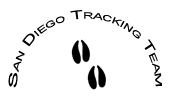SDTT Shows up at Tecolote Nature Center
Fred Kramer, Jedi Master of SDTT Outreach, fielded a gregarious crew to staff a table at the 4 June 2022 Tecolote Nature Center outreach event. The event, featuring speakers from SD City Council and from the Kumeyaay Nation, was attended by many friends of the Nature Center. Fred and staff - Evelyn, Kris, and Mickey - are shown below (photos by Kris and Fred).
SDTT Wildlife Surveys bounced back in Q1 2022
In the first quarter of 2022, SDTT and Anza Borrego Tracking Team (ABTT) combined to record 414 volunteer hours in the performance of wildlife surveys. We thank all of our volunteers for their time, interest, energy, and tracking skill. Nice comeback from the "shelter-in-place" days, weeks, months, and years of COVID-19 lock-down.
SDTT Data Collection Methodology
SDTT uses a data collection methodology for wildlife monitoring, reviewed by California Department of Fish and Wildlife (CDFW), US Fish and Wildlife Service, Conservation Biology Institute (CBI), and the City and County of San Diego, all represented on our Scientific Advisory Group. Our comprehensive data from 1996 through 2019 are available via the State of California BIOS database. Sample entry points to those data are here and here.
The Power of SDTT Data
SDTT data and knowledge have aided advocacy groups to make the case for changes to planned projects to protect existing wildlife corridors. Examples follow.
Wildlife corridors and linkages have been preserved either by getting development/construction projects changed or by having the land protected under the Multiple Species Conservation Program (MSCP):
I-5/I805 “merge” linkage;
Sorrento Valley road at Carmel Valley Creek corridor;
Rhodes Crossing;
fencing at Carmel Mountain and Box Canyon in Carlsbad;
sewage pumping station placement changed to keep it out of Los Peñasquitos Canyon;
baseline monitoring data set for CA Department of Fish and Game MSCP corridor study;
corridors connecting Los Peñasquitos Canyon Preserve with the Peñasquitos Lagoon, Del Mar Mesa, Deer Canyon, McGonigle Canyon, Black Mountain Open Space and the San Dieguito River Park.
Wildlife Tunnels and Culverts have been justified:
Palomar Airport Road;
Data to Endangered Habitats study re corridor enhancement in East County.
SR56 was moved out of Deer Canyon, thus preserving San Diego County’s last coastal canyon for its wildlife and habitats.
Advocates influenced planners of the pipeline project under Goodan Ranch to develop a less invasive and less intensive method of accomplishing their work.
Goodan Ranch advocates helped convince SDG&E to use less destructive techniques when building their Sunrise Power Link towers.
Wildlife-tunnel-size suggestions were provided based on our work with existing tunnels and culverts for a road-widening project between Escondido and Valley Center.
Data were provided for analysis of edge effects on various mammal species in certain open space areas before and after adjacent development.
SDTT Performed as a Sub-Contractor
SDTT uses a data collection methodology for wildlife monitoring, reviewed by California Department of Fish and Wildlife (CDFW), US Fish and Wildlife Service, Conservation Biology Institute (CBI), and the City and County of San Diego, all represented on our Scientific Advisory Group. Our comprehensive data from 1996 through 2019 are available via the State of California BIOS database. Sample entry points to those data are here and here.


